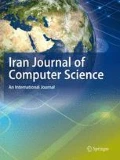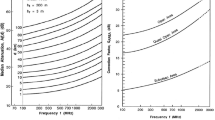Abstract
The right selection of a propagation model to describe the performance of a channel or collection of wireless network channels is an important aspect of LTE network simulation. There are a large number of propagation models that the NS-3 supports, 16 models in total. These propagation models are divided into three categories: abstract propagation loss models, deterministic path loss models, and stochastic fading models. In this research, these models are reviewed and described. Then LTE network modeling was performed using the COST-231 model. In this experiment, the rate of path loss in the LTE network was calculated and evaluated under three scenarios: the number of UEs increases while the number of eNBs stays constant, the spacing of the UEs relative to the eNBs changes, and the distance between the eNBs relative to each other changes. Based on the results, increasing the number of UEs in the eNB changes the average path loss in the cell. Also, the greater the UE distance from the eNB, the greater the path loss. In addition, if the eNBs do not interact with each other, the path loss within each cell will remain constant.









Similar content being viewed by others
References
Piro, G., Baldo, N., Miozzo, M.: An LTE module for the ns-3 network simulator. In: Proceedings of the fourth international conference on simulation tools and techniques (SimuTools), Barcelona, Spain, pp. 415–422 (2011)
Abbas, K., Afaq, M., Ahmed-Khan, T., Rafiq, A., Iqbal, J., Ul-Islam, I., Song, W.C.: An efficient SDN-based LTE-WiFi spectrum aggregation system for heterogeneous 5G networks. Trans. Emerg. Telecommun. Technol. 2020, 3943 (2020)
Stoffers, M., Riley, G.: Comparing the ns-3 propagation models. In: 2012 IEEE 20th international symposium on modeling, analysis and simulation of computer and telecommunication systems, pp. 61–67 (2012)
Campanile, L., Gribaudo, M., Iacono, M., Marulli, F., Mastroianni, M.: Computer network simulation with ns-3: a systematic literature review. Electronics 9(2), 272 (2020)
Marcillo, L.M., Aguiar, L.U., Paredes, M.P.: Wireless Channel 802.11 in NS-3. In: Preprints, article no. 2018090367 (2018)
Khana, R., Bilalb, S.M., Othmana, M.: A performance comparison of network simulators for wireless networks, pp. arXiv-1307 (2013)
Kurt, S., Tavli, B.: Path-loss modeling for wireless sensor networks: a review of models and comparative evaluations. IEEE Antennas Propag. Mag. 59(1), 18–37 (2017)
Prasad, K.S.N., Priyanka, S.P.: Propagation models for next generation networks in NS-3: a survey. Int. J. Eng. Res. Dev. 10(7), 54–60 (2014)
Hoomod, H.K., Al-Mejibli, I., Jabboory, A.I.: Analyzing study of path loss propagation models in wireless communications at 0.8 GH. J. Phys. Conf. Ser. 1003(1), 012028 (2018)
Ali, Z., Baldo, N., Bafalluy, J.M., Giupponi, L.: Simulating LTE mobility management in presence of coverage holes with ns-3. In: Proceedings of SimuTools, pp. 279–283 (2015)
Mollel, M.S., Michael, K.: Comparison of empirical propagation path loss models for mobile communication. Comput. Eng. Intell. Syst. 5(9), 1–10 (2014)
Zugno, T., Polese, M., Patriciello, N., Bojović, B., Lagen, S., Zorzi, M.: Implementation of a spatial channel model for ns-3. In: Proceedings of the 2020 workshop on ns-3, pp. 49–56 (2020)
Saleh, S.A., Dao, H., Zuhairi, M.F.: A comparative performance analysis of MANET routing protocols in various propagation loss models using ns3 simulator. J. Commun. 537–544, 2020 (2020)
Propagation: https://www.nsnam.org/docs/models/html/propagation.html (2021). Accessed 17 Mar 2021
Damosso, E., Correia, L.M.: Digital mobile radio towards future generation systems: COST Action 231, European Commission, Brussels, Belgium (1999)
Friis, H.T.: A note on a simple transmission formula. Proc. Inst. Radio Engineers 34(5), 254–256 (1946)
Erceg, V., Greenstein, L., Tjandra, S., Parkoff, S., Gupta, A., Kulic, B., Julius, A., Bianchi, R.: An empirically based path loss model for wireless channels in suburban environments. IEEE J. Sel. Areas Commun. 17(7), 1205–1211 (1999)
Rappaport, T.S.: Wireless Communications, Principles and Practice. Prentice Hall, Hoboken (1996)
Kun, S., Ping, W., Yingze, L.: Path loss models for suburban scenario at 2.3 GHz, 2.6 GHz and 3.5 GHz. In: 2008 8th international symposium on antennas, propagation and EM theory, pp. 438–441 (2008)
ETSI TR 138 901: Study on channel model for frequencies from 0.5 to 100 GHz, 3GPP TR 38.901 version 14.0.0 Release 14 (2017)
Zheng, Y.R., Xiao, C.: Simulation models with correct statistical properties for Rayleigh fading channels. IEEE Trans. Commun. 51(6), 920–928 (2003)
Benin, J., Nowatkowski, M., Owen, H.: Vehicular network simulation propagation loss model parameter standardization in ns-3 and beyond. In: Proceedings of IEEE Southeastcon, pp. 1–5 (2012)
Nakagami, M.: The m-distribution, a general formula of intensity distribution of rapid fading. Stat. Methods Radio Wave Propag. 3–36, 1960 (1960)
Author information
Authors and Affiliations
Corresponding author
Additional information
Publisher's Note
Springer Nature remains neutral with regard to jurisdictional claims in published maps and institutional affiliations.
Rights and permissions
About this article
Cite this article
Amini, P. A study on propagation models in NS-3 with a case study of LTE network modeling. Iran J Comput Sci 5, 279–287 (2022). https://doi.org/10.1007/s42044-022-00107-8
Received:
Accepted:
Published:
Issue Date:
DOI: https://doi.org/10.1007/s42044-022-00107-8




